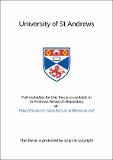Files in this item
Quantum interference effects : electromagnetically induced transparency and focusing
Item metadata
| dc.contributor.advisor | Dunn, Malcolm H. | en |
| dc.contributor.advisor | Sinclair, B. D. (Bruce D.) | en |
| dc.contributor.author | Fulton, David James | en |
| dc.coverage.spatial | 295p | en |
| dc.date.accessioned | 2021-04-08T09:04:25Z | |
| dc.date.available | 2021-04-08T09:04:25Z | |
| dc.date.issued | 1997 | |
| dc.identifier.uri | https://hdl.handle.net/10023/22035 | |
| dc.description.abstract | Theoretical and experimental studies of steady state quantum interference effects within an atomic vapour have been carried out. These include the effects of Electromagnetically Induced Transparency (E.I.T.), Electromagnetically Induced Focusing (E.I.F.) and inversionless lasing. Theoretical analysis was carried out using semi-classical density matrix models while experiments employed continuous-wave Ti:sapphire or Dye lasers within atomic rubidium. An initial study of the properties of E.I.T. was carried out within Doppler broadened rubidium. Coherently induced transparencies were generated in three basic systems: V-type, lambda and cascade. This allowed a theoretical and experimental comparison between the three systems to be made. The 5S1/2 - 5P3/2 - 5D5/2 cascade system proved the simplest in which to observe E.I.T., providing windows with depths > 90%. Thus, a fundamental study of E.I.T. within this system was carried out. This included the effect of varying optical field parameters and of Zeeman splitting. Highlighted by this analysis was the fact that E.I.T. can provide novel high resolution two-photon spectroscopy techniques. A unique non-dissipative cross focusing effect on the probe field was observed when the spatial profile's of the optical fields were considered. This was a direct result of the coherent interaction of the coupling field with the rubidium atoms and so was named Electromagnetically Induced Focusing. E.I.F. was shown, both theoretically and experimentally, to vary dramatically with changes in the system's physical parameters. An examination of the effects of varying the field wavelength's within all three systems was theoretically carried out. This analysis showed that a Doppler broadened medium does not require matched wavelength optical fields in order to observe coherently induced transparency. It also highlighted the relative roles of E.I.T. and Autler-Townes splitting within an induced transparency. A final study was carried out which theoretically predicts the presence of blue inversionless gain in a system which employed I.R. driving fields within atomic rubidium. | en |
| dc.language.iso | en | en |
| dc.publisher | University of St Andrews | en |
| dc.subject.lcc | QC446.F9 | |
| dc.subject.lcsh | Quantum interference | en |
| dc.subject.lcsh | Quantum optics | en |
| dc.title | Quantum interference effects : electromagnetically induced transparency and focusing | en |
| dc.type | Thesis | en |
| dc.type.qualificationlevel | Doctoral | en |
| dc.type.qualificationname | PhD Doctor of Philosopy | en |
| dc.publisher.institution | The University of St Andrews | en |
This item appears in the following Collection(s)
Items in the St Andrews Research Repository are protected by copyright, with all rights reserved, unless otherwise indicated.

